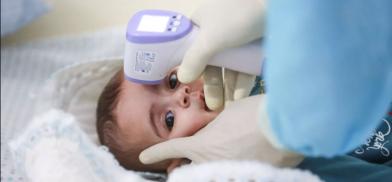Bhutan sees first probable infant COVID-19 case
The first infant COVID-19 case in Bhutan is suspected in a one-and-half-year-old child who arrived in the country recently along with the mother from India

The first infant COVID-19 case in Bhutan is suspected in a one-and-half-year-old child who arrived in the country recently along with the mother from India.
The mother, 35, tested positive to the virus while in the quarantine centre. The child tested positive on the rapid diagnostic test but could not be confirmed on the reverse transcription-polymerase chain reaction (RT-PCR).
As both the mother and child are asymptomatic, health officials, for now, have placed the duo in an isolation facility.
Health Minister Dechen Wangmo said that the child’s status could not be confirmed using the RT-PCR test mainly because it was difficult to get the nasal swab from an infant.
For a RT-PCR test, the sample used is a nasal swab also called a nasopharyngeal swab or culture. The sample is collected from the uppermost part of the throat, behind the nose using a long stick-like equipment.
People who have been tested for RT-PCR shared that it is a very uncomfortable and painful procedure.
“It feels like being stabbed in the brain. There is nothing pleasant about inserting that stick deep inside your nose,” said a health worker.
Lyonpo Dechen Wangmo said that although it is a probable positive case since the mother is positive, it was ‘inhumane’ to shove the swab down the throat of a crying baby just to prove he or she is positive.
“Imagine a health worker in full PPE shoving the swab down the baby’s nose. How traumatic would that be for the child?” the minister said.
Lyonpo said that even if the infant tests positive on the RT-PCR since there is no treatment, there is nothing that the clinical team could do.
“By conducting an RT-PCR test, we’d be just adding a number to our tally. But for me, I’m more concerned about the wellbeing of the child than adding a number on that 90,” she said.
“By doing a PCR forcefully on the child, the only assurance we would be getting is that he or she is positive. Then what next?”
Unlike other positive cases who are immediately moved to an isolation ward in the hospitals upon confirmation, the mother and child, for now, have been placed in an isolation facility, which is a hotel.
Lyonpo said that keeping them in the isolation facility was in line with the ministry’s guideline.
The minister had earlier said that in case of a community outbreak, all positive asymptomatic cases would not be taken to the isolation ward in the hospitals. These cases would be monitored in an isolation facility, which would be a hotel.
“Putting the mother and child in the hospital ward would unnecessarily expose them to risk and other infections,” she said. “Because the child is a suspected case, for now, we cannot practically separate the mother and the child. Moreover, both are asymptomatic and are in stable condition.”
The minister also clarified that the ministry or the government were not hiding anything from the public. “Instead we are caring for the child.”
She said that the decision to keep the mother and child in an isolation facility and for not testing the child on RT-PCR was based on consultation with the clinical and technical teams of the ministry.
Lyonpo said that the decision was taken after considering all the pros and cons and the possible psychosocial implication on the child. “Given the current situation this was the best solution made in the interest of the patient.”
Also for all COVID-19 patients whose immune system, if highly compromised, would be treated in a similar manner. Meaning, instead of moving them to a hospital ward, the patients would be treated in an isolation facility.
https://kuenselonline.com/bhutan-sees-first-probable-infant-COVID-19-case/








Post a Comment